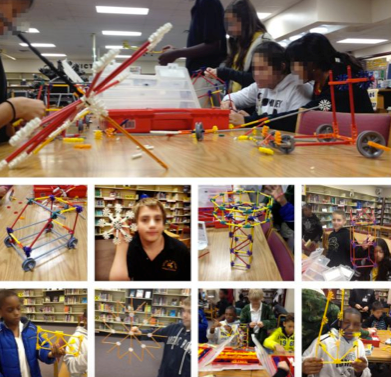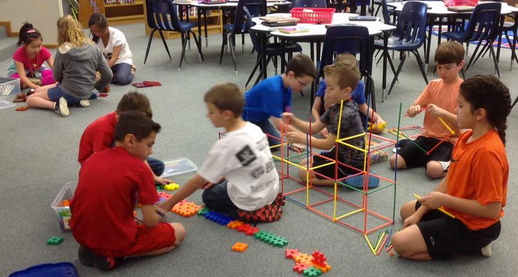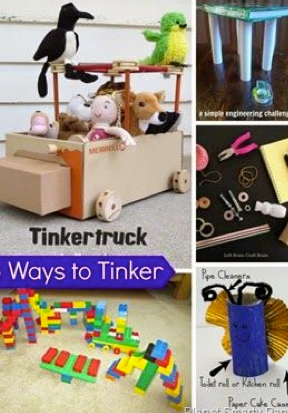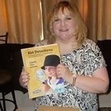Kim Caise's Blog, page 14
May 11, 2015
Sharks in the Classroom?
May 8, 2015
South Carolina Educators thank Stephen Colbert
 In conjunction through Donors Choose.org, Stephen Colbert donated $800,000 to fund classroom project and wish lists for 800 teachers in South Carolina. According to the
In conjunction through Donors Choose.org, Stephen Colbert donated $800,000 to fund classroom project and wish lists for 800 teachers in South Carolina. According to the
May 2, 2015
MakerEd/Maker Space Coming to a DENapalooza Near You
Today was the DENapalooza in San Antonio sponsored by Discovery Education. We had a fantastic learning from one another and sharing our favorite tools. I will be sharing some of those tools and ideas here and in my second book that I am editing and finishing up. Today I spoke at one of the breakout sessions to a great crowd and was so excited! I even got to share about my book, “
April 28, 2015
DENapalooza is Coming to San Antonio
April 19, 2015
Connecting Classrooms through Global Projects Webinar
 Many educators know and are constantly challenged to introduce new and innovative ways to reach their students and foster enthusiasm for the learning process. As an alternative to the textbook and current events model, global projects provide a unique approach to the educational process by introducing students to cultures and classrooms around the world.
Many educators know and are constantly challenged to introduce new and innovative ways to reach their students and foster enthusiasm for the learning process. As an alternative to the textbook and current events model, global projects provide a unique approach to the educational process by introducing students to cultures and classrooms around the world.
If you have been looking for a way to enrich your curriculum or increase the rigor and relevance of your learning activities, join me Thursday, April 30, 2015, at 7pm EST/6pm CST as we talk about what this strategy entails and easy ways to introduce participation in global projects to re-energize your teaching.
Join the webinar at the following links:
April 14, 2015
Webinar Topic Survey – Educators Please Assist
April 12, 2015
Webinar Topic Survey – Please Assist
April 8, 2015
What is Makerspace and Makered to You?
Many educators have their own interpretation of what a makerspace area is and what a makered project is. No one dislikes it more than when they are told their interpretation of an educational program or initiative is not a ‘correct’ interpretation.
A Makered Project – To Be or Not to Be – That is the Question!
For instance, many educators do not consider digital projects like audio or video projects as makered projects. I definitely disagree with this notion as the definition of a makered project is one where students create, explore, and learn content by MAKING something new out of a variety of materials, techniques or strategies. When students make digital products like a video, there is a progression of tasks that can include, but not limited to, storyboarding, writing a script, using a green screen, editing, voice overs, etc. The final result is a tangible product that students MADE thus making it a makered project in my opinion.
On March 30th, I conducted a webinar titled, “Makered/Makerspaces Coming to a Computer Near You!” and shared many resources and ideas on creating a makerspace classroom with makered projects similar to those shown below. I promised to share more pictures and ideas so I picked a few and listed them below. There are hundreds to choose from and this topic is of great interest to a large number of educators. I highly encourage you to check out Cari Young’s makered/makerspace Pinterest page. She has a huge collection of examples. If you scroll down to March 30th on my blog you can view the slides, Livebinder, and recording of the session.

3 D Pen-3doodler.com

Plastic items printed with a Makerbot 3D Printer

Makedo Makered Proj

Makered Projects in a Makerspace Classroom – Renovated Learning.com

Librarian9969’s students – Twitter

Makered Projects – Cari Young Pinterest
The above project images are considered ‘makered’ projects from a variety of sources. If you search for the hashtag #makered on Twitter you will find tons of examples, ideas, and resources for supplies for makered projects. You will be amazed at the awesome, intricate and complex projects that students are making. It is so exciting to see students engaged in learning activities and projects that the students enjoy, find interesting and meaningful, and teach to several of the CCSS/state standards.
Test Prep for CCSS and State Standards
When pressed and asked, “How does this prepared them for testing?” or “When are you going to teach test prep skills?”, the higher order thinking and critical thinking skills exhibited in makered projects is the best type of test prep in my opinion that students can experience. When you teach at a rigorous and complex level, students rise to the occasion and their performance rises as well. Give it a try and watch the faces of your students light up while completing a makered project on circuits instead of completing a worksheet or looking up vocabulary words about circuits. Nothing beats the real thing in action!
What are your thoughts on makered projects and makerspaces?



Use of Drones in Education?
April 7, 2015
“Oh Noah!” from PBS Kids
 I wanted to share the press release below for a great offering from PBS Kids for a program called “Oh Noah!”. Check it out and share the information with parents and colleagues.
I wanted to share the press release below for a great offering from PBS Kids for a program called “Oh Noah!”. Check it out and share the information with parents and colleagues.
ARLINGTON, VA and NEW YORK, NY, April 6, 2015 – The PBS KIDS digital series OH NOAH!(pbskids.org/noah) is expanding its offerings with new animated videos and games that introduce Spanish in an entertaining way. Launching on April 30 – a day to honor and celebrate children known as “El Día de los Niños” – new OH NOAH! content will include an immersive language learning game, “Lost and Found,” and a new 11-minute video, “Making a Splash.” In addition, starting on April 30 all OH NOAH! content will be accessible on mobile and tablet devices via pbskids.org/noah.
“Many parents are looking for tools to help their kids learn a second language, and research shows that developing a second language at a young age can have significant cognitive benefits; PBS KIDS is excited to offer families new content from OH NOAH! to help meet this need,” said Lesli Rotenberg, General Manager, Children’s Media, PBS. “Digital properties like OH NOAH! are among PBS KIDS’ many resources that further our commitment to helping children learn and grow through curriculum-based media across platforms.”
Geared to kids ages 4-7, OH NOAH! features the comic misadventures of Noah, a young boy staying with his grandmother in a community where almost no one else speaks English. As he tries to learn Spanish and makes new friends, misunderstandings land him in wacky predicaments, but he always manages to rebound and cheerfully learn from his mistakes. Since its launch in spring 2011, OH NOAH! has attracted a strong and growing audience online and introduced new Latino lead characters to children’s media. Emmy Award-nominated OH NOAH! is produced by THIRTEEN for WNET, New York’s flagship public media provider, and funded by the Corporation for Public Broadcasting.
“OH NOAH! provides children and their parents with a delightful variety of ways to learn Spanish together with Noah, who is a charming and funny role model,” says Sandra Sheppard, Executive Producer and Director of Children’s and Educational Media, WNET. “He’s joined on his adventures by his pet mouse—and fan favorite—Pequeño and an expanded cast of characters, including his new best friend Nell.”
WNET is partnering with a variety of organizations to extend the reach of OH NOAH!. Through a new partnership, the national steward organization for “El Día de los Niños,” the National Latino Children’s Institute, will help leverage OH NOAH! content in key communities across the country at events on April 30. And, as part of a partnership with the National Council of La Raza, OH NOAH! will participate in NCLR’s Annual Conference and National Latino Family Expo in Kansas City July 11-14.
According to the Center for Applied Linguistics, benefits of early language learning include improving a child’s understanding of his or her native language, having a positive effect on intellectual growth, enriching and enhancing a child’s mental development and promoting more flexibility in thinking, greater sensitivity to language and a better ear for listening.
“The educational foundation of OH NOAH! is based on the idea that kids learn language best in context,” says Mariana Swick, bilingual education advisor for OH NOAH!. “Children’s identification with Noah and his mishaps provide motivation – the most important factor for success in learning a new language.”
As the Latino population has increased significantly in the U.S., so has interest in teaching children Spanish. That interest extends to Latino families themselves. According to the Pew Hispanic Center, nearly 65% of U.S. Latinos speak only English at home or speak it very well, and 95% say it is important for their children to know Spanish, too.
New content launching April 30 on pbskids.org/noah will include:
“Making a Splash,” a new 11-minute video: On a sweltering day, Brisa invites Noah and Nell to go swimming. Noah is hesitant because he can’t swim. With Nell’s encouragement, Noah decides to get swimming lessons, but because of a misunderstanding, Noah ends up performing tricks with a waterskiing team instead. After the ski team agrees to give him swimming lessons, Noah declares “¡Puedo nadar!” triumphantly.
An interactive “Games in Video” version of the “Making a Splash” video that includes embedded language-learning mini-games.
New short videos, including an extended version of the music video “Puedo nadar!” (“I can swim!”) and a highlight reel of Pequeño’s funniest moments from the series.
“Lost and Found,” a new immersive language-learning game: Players join Noah and Nell on an interactive scavenger hunt. Players seek help from friends and neighbors to decipher Spanish words and locate missing objects, and encounter a series of fun mini-games along the way.
OH NOAH! is now mobile-friendly and accessible through smartphones and tablets.Educational resources related to the new video and games will be available for students and educators on PBS LearningMedia. In addition, a new printable family activity guide and other activities designed for use by parents and caregivers with their children will be available on the OH NOAH! and PBS Parents websites. The OH NOAH! website (pbskids.org/noah) offers thirteen three-minute videos with an embedded “Match It” game that helps children learn vocabulary, as well as five other learning games. OH NOAH! videos are also accessible on the free PBS KIDS Video App, which is available on a variety of mobile devices and on platforms such as Roku, Apple TV, Amazon Fire TV and Chromecast.
As a result of participating and using the resources of the OH NOAH! website, interest in teaching in Spanish increased as well as the skills of the students. Below is a YouTube video about the program.







